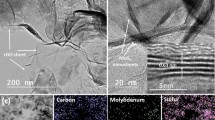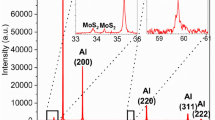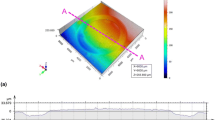Abstract
Tribological behavior of Cu–MoS2 and Ag–MoS2 nanocomposite lubricant was studied. Cu nanoparticles produced by electrical explosion of copper wires and Ag nanoparticles prepared by electrospark erosion were employed as metal cladding modifiers of MoS2 nanolamellar particles. The tribological tests showed Cu–MoS2 and Ag–MoS2 nanocomposite lubricants changed the friction coefficient of the initial grease and essentially improved its wear resistance.
Similar content being viewed by others
Background
Molybdenum and tungsten disulfides due to their anisotropic layered crystal structure are characterized by unique properties. These materials are good solid lubricants and antifriction additives to oil and greases (An and Irtegov 2014), moreover MoS2 is a promising material for lithium ion batteries (Wang et al. 2010). With respect to application of molybdenum and tungsten disulfides as lubricants, the synthesis and the appropriate state of dispersed materials or films play an important role. For improving tribological properties of MoS2 several methods are used: decreasing the particle size (Hu et al. 2010), creation of adaptive lubricants (Prasad et al. 2000), a composite mixture with other lubricants etc. As concerns composite lubricants, Sb2O3–MoS2 (Zabinski et al. 1993), Ag–MoS2 (Zhang et al. 2012), Ti–MoS2 (Renevier et al. 2001; Ilie and Tita 2007), Ni–WS2 (Wang et al. 2008) composites have shown a positive effect on tribological properties in comparison with pure compounds. Copper and copper alloys are well known lubricant materials due to the zero-wear friction effect discovering in 1956 (Garkunov 2000) and widely used in composite lubricants with molybdenum disulfide, especially for applications in vacuum (Kolesnichenko et al. 1986; Merstallinger et al. 2007; Kato et al. 2003). However, a synergetic effect of excellent antiwear properties of copper and antifriction behavior of MoS2 is observed in air at room temperature (An et al. 2014). The present paper is devoted to the study of the composition dependence on tribological properties of greases doped with Cu–MoS2 and Ag–MoS2 nanocomposites.
Results and discussion
An SEM image of nanolamellar MoS2 (n-MoS2) produced by self-propagating high-temperature synthesis (SHS) from electroexplosive molybdenum nanopowders and pure elementary sulfur is presented in Fig. 1. The particles possess a layered hexagonal shape. According to the XRD data, the main phase in the final SHS products is 2H-MoS2. The prepared n-MoS2 particles mixed with n-Cu and n-Ag particles in different ratios were then added to the Litol and VNIINP greases. All samples were subjected to tribological tests.
Figure 2 shows the evolution of the friction coefficient versus time for the commercial grease VNIINP undoped and doped with composites of nanolamellar MoS2 and copper nanoparticles, 5 and 7 wt%, respectively. The doped grease reveals a lower average friction coefficient (μaver. = 0.09) than that of undoped grease (μaver. = 0.11). At the same time, doping the grease with the composition of nanolamellar MoS2 with n-Cu leads to a friction coefficient more stable in time. Apparently, this fact is related to the metal cladding effect caused by the presence of copper nanoparticles.
Figure 3 displays the friction coefficient versus time for the n-MoS2 doped with n-Cu in different ratios: 2, 7, 25, and 50 wt% n-Cu. Surprisingly, the lowest average friction coefficient (μaver. < 0.025) was found for n-MoS2 doped with 7 wt% n-Cu. It is lower than that of n-MoS2 doped with 2 wt% n-Cu (μaver. ~ 0.027). It should be noted again that copper nanoparticles impact positively on the stability of the friction coefficient in time in comparison with undoped n-MoS2. The n-Cu particles clad wear fissures on the surface that leads to the formation of a soft tribofilm which allows n-MoS2 particles to slide on the copper tribofilm easier than on the steel disk surface. The formation of the tribofilm was verified by the AFM measurements.
The doped Litol grease showed remarkable results for the tribological tests (Fig. 4). The lowest friction coefficient (μaver. ~ 0.09) was detected for the grease Litol doped with 5 % of the n-additive (n-MoS2 + 7 % n-Cu). This value is lower in comparison with the undoped Litol grease or doped with 5 % of n-MoS2.
Figure 5 and Table 1 illustrate appropriate antiwear properties of n-Cu and n-Ag additives to the Litol and VNIINP greases. 5 %-additives of n-MoS2 shows even an increase in wear which is apparently related to humidity conditions and a not-stable state of n-MoS2 in the grease. The presence of spikes in the wear tracks is probably related to random contacts between the disk and the ball. Nevertheless, n-MoS2 doped with n-Cu or n-Ag can reduce wear. In case of the VNIINP grease, wear can be even negative because of the ovecladding effect when copper nanoparticles “splice” the steel surface. The AFM measurements are also in good agreement with such an assumption.
Conclusions
Composite greases containing nanolamellar MoS2 doped with Cu and Ag nanoparticles were successfully prepared for tribological tests. The performed tribological tests showed the better antifriction performance for both the solid n-MoS2 lubricant doped with copper nanoparticles and the Litol and VNIINP greases doped with n-MoS2 with copper nanoparticles. Electroexplosive copper and electroerosive silver nanoparticles can improve the n-MoS2 tribological performance due to a visible rise in antiwear characteristics. At the same time, we can expect essential improvement of oxidation stability of the greases doped with the studied metal nanoparticles, especially with n-Ag. Another explanation for the improvement of the properties is related to a synergetic effect in using nanolamellar molybdenum disulfide and metal cladding additives of Cu and Ag nanoparticles.
Experimental
MoS2 nanolamellar particles (n-MoS2) produced by self-propagating high-temperature synthesis (SHS), as well as copper (n-Cu) and silver nanoparticles (n-Ag) obtained by electrical explosion of wires (EEW) and electrospark erosion, respectively, were used for preparing a composite lubricant. SHS of metal sulfides from metal nanopowders is discussed in Irtegov et al. (2012). Conditions and parameters of electrical explosion of copper wires are presented in An et al. (2014). The initial powders were analyzed using an X-ray diffractometer Shimadzu XRD-7000 diffractometer (CuK α irradiation) and a scanning electron microscope (JSM-7500FA, JEOL). In order to minimize agglomeration, the nanoparticles were subjected to ultrasonic treatment in an organic solvent before the preparation of the greases. For tribological tests MoS2 nanolamellar particles and Cu nanopowder are mechanically mixed during 30 min. Copper content in composite lubricant was 2, 7, 25 and 50 wt%, respectively. Besides, a solid lubricant, complex soap based greases (LITOL and VNIINP) with Cu–MoS2 additives were produced by dispersing using ultrasonic bath. Before dispersing, viscosity of greases was decreasing by addition of hexane. After dispersing composite greases are dried at room temperature during 24 h. Tribological investigations of pure nanolamellar MoS2, composite Cu–MoS2 lubricants and greases were carried out by “ball-on-disk” PC-Operated High Temperature Tribometer TXT-S-AH0000, CSEM. The wear scar was explored on a noncontact profilometer Micro Measure 3D Station, STIL. All tests were carried out using a 30 mm diameter medium-carbon steel disks as the friction body, and a vanadium-cobalt ball of diameter 3 mm was used as the counterface. The tests were run using a load of 5 N and sliding speed of 5 cm/s, with track diameter 3 mm, duration of tests was 30 min. The mean contact pressure was 0.56 N/mm2. After friction tests surface of wear scars were analyzed using an atomic force microscope Ntegra Aura (NT-MDT, Russia).
References
An V, Irtegov Y (2014) Tribological properties of nanolamellar MoS2 doped with copper nanoparticles. J Nanomater Article ID 731073
An V, Irtegov Y, de Izarra C (2014) Study of tribological properties of nanolamellar WS2 and MoS2 as additives to lubricants. J Nanomater Article ID 865839
Garkunov DN (2000) Triboengineering (wear and non-deterioration). Moscow Agricultural Academy Press, Moscow (in Russian)
Hu KH, Hu XG, Xu YF, Huang H, Liu JS (2010) The effect of morphology on the tribological properties of MoS2 in liquid paraffin. Tribol Lett 40:155
Ilie FI, Tita CM (2007) Tribological properties of solid lubricant nanocomposite coatings obtained by magnetron sputtering of MoS2/metal (Ti, Mo) nanoparticles. Proc Romanian Acad 8:000–000
Irtegov Y, An V, Azhgikhin M (2012) Study of nanostructured metal sulfides produced by self-propagating high-temperature synthesis. In: Proceedings of 7th international forum on strategic technology, IFOST 2012, article number 6357544
Kato H, Takamaa M, Iwai Y, Washida K, Sasaki Y (2003) Wear and mechanical properties of sintered copper–tin composites containing graphite or molybdenum disulfide. Wear 25:573
Kolesnichenko LF, Fushchich OI, Yulyugin VK, TkachenkoYG Donets IG (1986) Tribotechnical characteristics of self-lubricating copper base powder materials at elevated temperatures. Sov Powder Metall Metal Ceram 25:136
Merstallinger A, Fink M, Neubauer E, Eder J, Holzapfel Ch, Seiler R, Gaillard L, Pambaguian L (2007) Self lubricating copper composites for tribological applications at medium temperatures in space. In: Proceedings of 12th European space mechanisms and tribology symposium (ESMATS)
Prasad SV, McDevitt NT, Zabinski JS (2000) Tribology of tungsten disulfide–nanocrystalline zinc oxide adaptive lubricant films from ambient to 500 °C. Wear 237:186
Renevier NM, Hamphire J, Fox VC, Witts J, Allen T, Teer DG (2001) Advantages of using self-lubricating, hard, wear-resistant MoS2-based coatings. Surf Coat Technol 142:67
Wang AH, Zhang XL, Zhang XF, Qiao XY, Xu HG, Xie CS (2008) Ni-based alloy/submicron WS2 self-lubricating composite coating synthesized by Nd:YAG laser cladding. Mater Sci Eng 475:312
Wang S, Li G, Du G, Jiang X, Feng C, Guo Z, Kim S (2010) Hydrothermal synthesis of molybdenum disulfide for lithium ion battery applications. Chin J Chem Eng 18:910
Zabinski JS, Donley MS, McDevitt NT (1993) Mechanistic study of the synergism between Sb2O3 and MoS2 lubricant systems using Raman spectroscopy. Wear 165:103
Zhang W, Demydov D, Jahan MP, Mistry K, Erdemir A, Malshe AP (2012) Fundamental understanding of the tribological and thermal behavior of Ag–MoS2 nanoparticle-based multi-component lubricating system. Wear 288:9
Authors’ contributions
VA carried out the main conception and the main tribological experiments, participated in the analysis and interpretation of data. EA and IS carried the main tribological experiments and participated in the analysis interpretation of the data obtained. VD, NB, MK participated in the development of the main conception and its interpretation. All authors read and approved the final manuscript.
Acknowledgements
This work was supported under the state assignment of the Ministry of Education and Science of Russia for 2014–2016 (Research Work No. 361) and by the Russian Foundation for Basic Research (Project No. 15-38-50081). The authors would like to thank the Nano-Center and Scientific Analytical Centre at Tomsk Polytechnic University for the XRD, TEM and SEM analyses. Tribological tests were done using the equipment of the Material Properties Measurements Centre of TPU.
Competing interests
The authors declare that they have no competing interests.
Author information
Authors and Affiliations
Corresponding author
Rights and permissions
Open Access This article is distributed under the terms of the Creative Commons Attribution 4.0 International License (http://creativecommons.org/licenses/by/4.0/), which permits unrestricted use, distribution, and reproduction in any medium, provided you give appropriate credit to the original author(s) and the source, provide a link to the Creative Commons license, and indicate if changes were made.
About this article
Cite this article
An, V., Anisimov, E., Druzyanova, V. et al. Study of tribological behavior of Cu–MoS2 and Ag–MoS2 nanocomposite lubricants. SpringerPlus 5, 72 (2016). https://doi.org/10.1186/s40064-016-1702-y
Received:
Accepted:
Published:
DOI: https://doi.org/10.1186/s40064-016-1702-y









